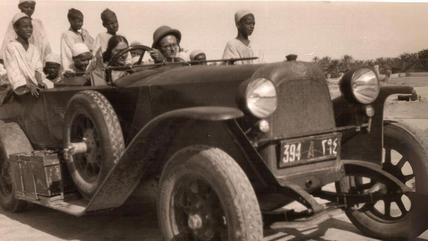The neighbourhood that shaped a nation

Revisiting the history of a place like the Jewish Quarter in Cairo, Egypt's capital, can spark fierce and heated debate, particularly on social media platforms and amid the war on Gaza. This is exactly what happened when Ahmed Zakaria Zaki's book, "The Jewish Quarter During the Nineteenth Century", was introduced at the Cairo International Book Fair last January.
Some criticised the choice of subject matter, arguing that attention should be directed instead towards the history of the Palestinian cause and the ongoing events in Gaza. Others countered that documenting and learning from history are essential.
In the introduction of his book, Zaki describes his journey to uncover the history of the Jewish Quarter as "insane". He notes that the two-volume work covers the history of a place located in Cairo's historic Gamaliya district, which is no wider than a few hundred meters, yet rich in details of the heritage of Egyptian Jews. Zaki, a professor at the Faculty of Engineering, Cairo University, told Qantara that his research led him to discover that almost every major development in modern Egypt originated in that quarter.
Zaki, who has authored several works on the lives of Jewish people in Egypt, points out that most existing books and studies have neglected this particular era, instead focusing on the aftermath of the rise of the Zionist movement in the 20th century and the foundation of the State of Israel.
He adds: "The strategic location of the Jewish Quarter in the heart of 19th-century Cairo turned it into a cultural port of call for foreign visitors, orientalists, and travellers, especially given that many Jews were fluent in foreign languages and worked in currency exchange."
From persecution to prosperity
The book begins with the arrival of Napoleon Bonaparte's French campaign in Egypt in 1798—a golden moment for Egypt's Jews, who had previously suffered greatly under Ottoman rule and its local representatives, the pashas. Under the Ottomans, Jews had been forbidden from riding horses or bearing arms, restrictions that Bonaparte lifted in an effort to win over the persecuted minority.
And yet, the book notes that social conditions within the Quarter remained difficult, according to documentation by French scholars of the famous work "Description de l'Égypte". They described the Jewish neighbourhood as filthy and miserable, with alleys so narrow that two people could not pass side by side.
The book then shifts to another episode in Egypt's history: the rule of Muhammad Ali Pasha (1805–1848), considered the founder of modern Egypt. Under his rule, which sought to reject religious fanaticism, new synagogues were built in the Jewish Quarter and a greater number of Jews began to arrive in Egypt, especially European Jews fleeing persecution on the continent.
Egypt also became a favoured destination for foreign travellers and orientalists, with the Jewish Quarter attracting particular scholarly interest. However, as Zaki notes, many of their written accounts are "rife with anti-Semitism, Islamophobia, and a general sense of superiority over the natives."
The French writer Félix Mengin, in his book on Egypt's history, described the Quarter as having "extremely narrow streets, closely packed houses with dark interiors that block air circulation, resulting in widespread disease." He adds that "most of the residents of the Quarter suffer from eye diseases, particularly conjunctivitis, plainly visible on their faces, which are covered in acne caused by the excessive consumption of sesame oil."
Conjunctivitis was not confined to the Jewish Quarter: it was widespread among the Egyptian population, with many losing sight in one or both eyes, Zaki highlights.

Fleeing the Nazis and thriving in Cairo
Many Jewish musicians fled Nazi Germany in the 1930s and 1940s. Composer Brigitte Schiffer was one of the few who put down roots in Egypt. In this interview, the German music professor Matthias Pasdzierny charts her unusual story.
Nostalgia for the Jewish Quarter
In another account cited in the book, Mengin notes the Jews' deep attachment to the Quarter, which they longed for when abroad, even while in Paris, ostensibly the capital of Western civilisation at the time. He recounts a conversation with a Jewish woman who had moved from Cairo to Paris, who wistfully said, "Ah, sir, where is Cairo and where is the Jewish Quarter? I ask myself: Is love for one's homeland stronger than all else?"
The English Jewish novelist (and later British Prime Minister) Benjamin Disraeli also captured his impressions of the Quarter through the words of a character called Sidonia in his novel, "Coningsby": "The Arabs are but Jews upon horseback, and all are Easterners at heart."
Over time, the Jewish Quarter emerged from the isolation depicted by early travellers and orientalists. Jews increasingly took part in the state's administrative apparatus as accountants and translators for foreign missions, in addition to their traditional roles in currency exchange and speculation.
The book offers testimonies about the religious tolerance that characterised relations between the Jews of the Quarter and their Muslim and Christian neighbours. The English orientalist Edward William Lane, for instance, noted that the Jewish rabbi often mediated to resolve minor disputes, not only among the Jews themselves but also with their Coptic neighbours in the Orthodox Roman Quarter or Muslims in the Gamaliya district.

The reader may be struck by a particular scene from 1846, when the eminent military leader Ibrahim Pasha, eldest son of Muhammad Ali Pasha, ordered a grandiose funerary procession for Chief Rabbi Yosef Moshe al-Jazi, culminating in the Jewish cemetery in Basatin, south of Cairo. Ibrahim Pasha even lent his own carriage to carry the rabbi's coffin, causing a stir among members of other religious communities around the unusual spectacle.
The Quarter was not a "Ghetto"
The book emphasises that the Jewish Quarter was never a "ghetto" in the sense often portrayed in writings about Egyptian Jews. Zaki marshals ample evidence to support this claim, including the fact that, in 1870, the Islamic reformer Jamal al-Din al-Afghani—an influential figure in Egypt's cultural and intellectual life at the time—chose to reside in the Quarter.
After being unable to deliver lectures at Al-Azhar Mosque, al-Afghani turned his home in the Jewish Quarter into an intellectual salon frequented by students and Egyptian thinkers, including the prominent Sheikh Muhammad Abduh and nationalist leader Saad Zaghloul.
It was in that very house in the Quarter that al-Afghani first coined the slogan "Egypt for the Egyptians", a rallying cry that would later become central in the struggle against foreign occupation. Al-Afghani sought to replace religious bonds with national ones, advocating unity among the three Abrahamic faiths.
The Quarter also produced one of Egypt's earliest pioneers in the realm of journalism: Yaqub Sanu, who launched the first satirical magazine in Egyptian history, Abu Naddara Zarqa’ (The Man with the Blue Glasses). However, his mocking of Khedive Ismail led to the magazine's expropriation and Sanu's exile to France.

Multi-religious life in the Jewish Quarter of Damascus
Syrian author Moussa Abadi depicts peaceful coexistence in the Jewish Quarter of 1920s Damascus in ‘The Queen and the Calligrapher’. The characters may be quirky and the stories bizarre, but they show us that the Damascus of yesterday could be a model for our own time.
In 1879, the Quarter witnessed another remarkable event: the Chief Rabbi, the Sheikh of Islam, the Coptic Patriarch and several figures of the Egyptian national movement jointly signed a nationalist manifesto opposing foreign domination over Egypt, then sinking into debt under European powers.
A turning point
Throughout this history, one striking contradiction emerges: as the Jewish community in Egypt grew in prosperity during the nineteenth century, wealthy Jews began leaving the Quarter for more upscale areas such as Ismailia (now downtown Cairo) and the northern suburbs. Over time, only the "miserable", as they were called, remained in the Quarter.
Zaki's book narrates the history of the Quarter up until the end of the 19th century, when the first Zionist Congress was held in 1897, advocating the establishment of a Jewish state in Palestine. This led to the founding of the first Zionist association in Cairo, mainly composed of Ashkenazi Jews. However, the movement found little support or presence within the Quarter itself, which was predominantly Sephardic, before the century's end.
At the moment, Zaki is working on a new book documenting the dramatic transformations which the Jewish Quarter experienced in the 20th century—from the influx of Muslim residents in the mid-1950s, to the establishment of the State of Israel, the emigration of young Jews, and the aging of those who remained behind, culminating in the near-total disappearance of Jewish presence in the Quarter.
This article is an edited translation of the Arabic original. Translation by Basyma Saad.
Qantara ©
